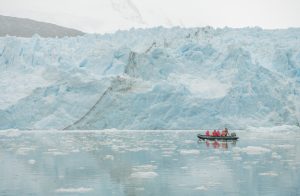We asked Associate Professor in Marine Climate Risk and glaciologist, Ian Goodwin, for some information about the spectacular Chilean glaciers. Ian joined us on our Chilean Fjord Adventure March 31st, 2019 and will be returning to travel with us in 2020.

Some of the most spectacular glaciers drain ice from the Patagonian Ice Caps high in the Andes and the Cordillera Darwin in Tierra del Fuego to the Chilean Fjords and the Pacific Ocean. The Patagonian Ice Caps represent the third largest ice masses on the planet after Greenland and Antarctica. The Patagonia Andes can be thought of as northern extension of the Antarctic Peninsula. Both regions are a hotspot for climate change as evident in the retreat of these great glaciers.
Over the past 50 years, the great Southern Hemisphere westerly wind belt has been observed to migrate to more southerly latitudes and as a result, the Patagonia Andes are receiving more frequent warm tropical air and rain, rather than cold air and snow. These factors combined are responsible for the dramatic retreat and melting of the Chilean and Tierra del Fuegan glaciers. Hence, we are witnessing a shift from glacial to fjord landscape.
The greatest glacial retreat is occurring where the glaciers terminate in deep fjords and once the ice thins, the glaciers have rapidly retreated landwards. Many glaciers terminate on land at the edge of fjords and have shown much more modest retreat in recent years. There remains a vast network of glaciers descending from the mountains to the sea, discharging their icebergs into verdant green-forested fjords. The changes that are occurring throughout the Chilean Glaciers and fjords make it an exciting time to observe rapid climate change on our planet.
If you would like to join A/Prof Ian Goodwin on our Chilean Fjords Adventure to learn more about the Chilean glaciers, please contact your preferred agent or our sales team here.















